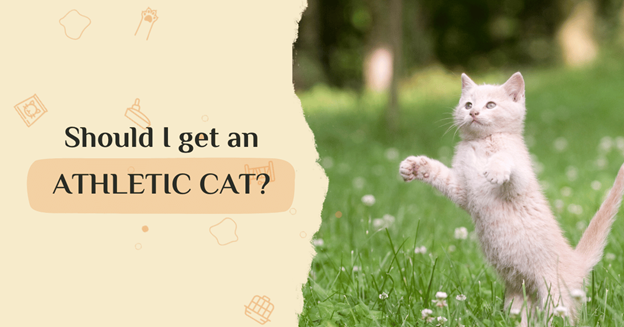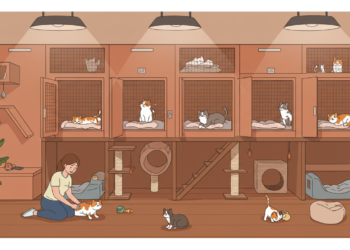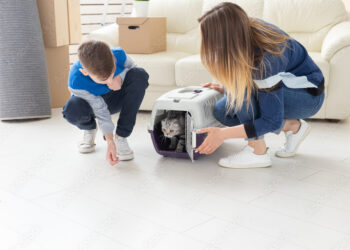Are you looking for a furry friend that provides you an instant outlet for fun and play? An athletic cat is a great companion for active pet owners because of their agility, fascinating moves, and loving nature.
After consulting with a vet and lot of research, I have composed a guide on everything you need to know about owing an athletic cat.
Having an athletic cat has different benefits such as they don’t bark or growl like dogs. Cats need less space, smaller amounts of food as compared to dogs. Athletic cat makes you happy on your return to home and provides a quick outlet for enjoyment and play.
Let’s discuss why your cat always lands on its feet from heights you cannot imagine! We will talk about the following:
- Body features of athletic cats
- Types of athletic cats
- Breeds to adopt for athletics
- The benefit of getting an athletic cat
- Maintenance and diet of athletic cat
Body Features
Athletic Cats have flexible spines, retractable and extendable claws, and strong muscles that create a grip similar to runner’s spikes. Their body’s capacity to stretch benefits them in athletics. Its sprinting stride is three times longer than its body length. The bending and straightening of their spines result in a more robust and flexible gait.
Types Of Athletic Cats
Cats are designed to thrive in sporting endeavors. The only thing that matches their supremacy in speed, accuracy, and adaptability is their astonishing capacity to sleep 12 to 16 hours every day. Jealous, eh?
1. The Player
Cats love to play with objects because of their natural instinct. Toys act as exercise stimulus for cats. Their paws are swift, and they have exceptional object control.in the beginning or evolution of cats from tigers, ice hockey was meant for breaking an ice to catch a fish.
Cats can play Ice hockey and can leave you defeated. Ice hockey aims to push the puck across the ice and into the other team’s goal. Who possesses these talents more naturally than a cat? Have you ever witnessed a cat bat a toy smoothly across the room?
2. Sprinters
If you’ve ever witnessed a cat’s “zoomies,” you’ll likely agree that cats sprint to like nobody’s business. They may travel from one end of the home to the other so quickly that you will need more time to set a timer. Oh, and we’re very positive that their excessively inflated tail and occasional vocalizations while sprinting feed their athletic drive.
3. High jumpers
Cats’ muscular hind legs allow them to jump from the floor to the kitchen counter and other (often restricted) areas. Olympic athletes probably watch cat videos as part of their preparation.
4. Hurdlers
Occasionally, our felines move through the home with the elegance of gazelles and leap over barriers with bounding bounds. Their seemingly effortless leaps over chairs, trash cans, and even us resemble those of athletic hurdlers. Food or a moth are the two things that can halt a leaping cat in his tracks.
Breeds To Adopt For Athletics
There are 12 known athletic breeds if you are looking for a kitty athlete:
- Abyssinian: Medium-sized having a muscular body
- Somali: Medium-sized, long hair coat, friendly
- Bengal: Asian leopard cat ancestor, wild appearance
- Cornish Rex: Small-sized, greyhound-like appearance
- Devon Rex: Medium-sized, intelligent, and affectionate, washboard-like appearance
- Egyptian Mau: long-sized with agility activities
- Japanese Bobtail: Medium-sized and friendly
- Ocicat: wild look and spotted appearance
- Siamese: medium-sized and social behavior
- Balinese: Jumping and climbing breed, medium-sized
- Oriental Shorthair: highly prey drive
- Singapura: smallest among all, social and affectionate
Reading Suggestion: British Longhair Cat
The Benefit Of Getting An Athletic Cat
- Cats reduce your levels of tension and anxiety. Those who own cats are well aware of the power of a single session of caressing or playing with their feline companion to transform an otherwise unpleasant day into a pleasant one.
- owning a cat can improve your heart health and reduce risk of death from heart stroke. A study has shown that those who keep cats have a decreased chance of developing cardiovascular disease and stroke.
Studies show that Pets like cats and dogs have a calming effect for their owners and it reduces risk of anxiety, blood pressure problems that are the leading cause of heart attack.
- Cats help to alleviate the sense of isolation you have. Stroking a cat increases secretion of love hormone in pet parents. Release of oxytocin (love hormone) as a result of interaction with your pet makes you happy.
What Will You Need With An Athletic Cat?
Maintaining an athletic cat is as essential as its diet because obesity is the number one challenge for the athletic cat. Here are some exercises for them for agility training.
Pair-up exercise partners: A simple solution for ensuring that felines receive the necessary cat activity since cats do not respond to play requests as readily as dogs do.A pair of cats who get along will receive plenty of exercise via wrestling and chasing games. Reward them with their favorite toys or treats.
Have an abundance of toys on hand. Because cats tend to be considerably more alone than dogs, the ideal technique for cat exercise is to provide them with various toys. And these do not need to be expensive pet store toys, either. You can use everyday home items as toys to encourage cats to exercise. Consider tennis balls or rolled-up pipe cleaners.
Enjoy playing with lasers. Few items will amuse you more or get your cat moving quicker than a laser pointer attached to the end of a pen or leveling tool. Laser toys are sometimes a good source of amusement. But they must be accompanied by a genuine toy the cat can catch to prevent obsession and frustration from the cat’s inability to catch the light beam. Beware: Never flash the spotlight straight into the eyes of the cat.
Use catnip with discretion. Catnip is an excellent tool for encouraging your cat to exercise, but use it only in the appropriate circumstances. Note that not all cats respond to catnip, and of those that do, a small percentage will become violent. Additionally, never administer catnip before a stressful occasion, such as a trip to the veterinarian. Your vet will appreciate it!
Supervise your cat’s use of a treadmill or wheel. Training a cat to run on a treadmill for exercise is possible. It is better to begin while they are young, full of activity, and easily enticed by a toy. Also, you should constantly monitor the cat on the treadmill. Cats can run up to 30 miles per hour, but you should start slowly and gradually increase the pace because you do not know your cat’s speed.
Go outdoors. With the correct training and equipment, you can educate your cat to walk outside on a leash and harness like a dog. Ensure that the harness fits properly and cannot be removed.
Juvenile Cats Are Simpler To Teach, But Persistence Is Required
First, let them adjust to the harness, then attach the leash and allow them to drag it, and last, grasp the leash and apply slight pressure. It might take up to two weeks to get them completely acclimated, or they may adapt rapidly.
Establish an agility course. If your cat is exceptionally active and nimble, try cat agility activities. You may be more accustomed to these tasks for dogs or horses, but cats equally love this combination of speed and difficulty. These programs feature a variety of challenges, such as bars to leap over and tunnels to traverse, that challenge your cat physically and psychologically.
The diet of an athletic cat is of equal significance as physical exercise. Cats, as obligate carnivores, can only get the nutrition they need from animal foods. Cats are carnivores by nature; therefore, their diet must consist primarily of meat and other animal products, with some modest fat and minimal carbs. Vitamins, minerals, fatty acids, and amino acids are only some of the many essential nutrients cats need.
When you have an athletic cat as your furry friend, you have to be more careful at the giving end. You must provide it with a high-protein diet with the right mix of carbohydrates. The athletic cat needs more omega-3 fatty acids and enough water to keep hydrated. Be careful to provide them with a healthy mix of wet and dry food. You may also seek the advice of a veterinarian if you want to learn more about the appropriate foods to give your pet.
Things To Be Aware Of With An Athletic Cat
If your cat is hyperactive even at night, here are some Do’s that can help you with this issue.
Structure their playtime
You may lessen undesirable or excessive behavior in your cat by including playtime in its routine and giving it some structure. Using cat-friendly toys like interactive LED laser pointers or a tennis ball that’s been customized to include rewards may be effective.
Make your household more harmonious
Because the ancestors of the domestic house cat were solitary hunters, living in a home with several cats or other pets might be stressful for domestic house cats. Urine marking, urinating or defecating inappropriately, or doing outside the litter box are all apparent indications that your cat is stressed. If your cat exhibits signs of stress, it is time to seek professional help from an animal behaviorist or a veterinarian.
Take care of any hyperthyroid problems
Not every annoying habit shown by cats can be attributed to their behavior. Hyperthyroidism is the condition that affects elderly cats the most frequently and is the most likely cause of hyperactive behavior. Cats that have this ailment have a hyperactive thyroid gland, which is the mechanism that controls the amount of energy that they have. In the end, you’ll have a cat that’s full of boundless amounts of energy.
The final say is, when properly socialized, each of the breeds has the propensity to have pleasant, extroverted personalities, and practically identical to those of dogs. Nonetheless, these cats need owners who have enough time and energy to connect with them regularly or have friends, such as another cat or dog, so they can keep out of trouble and not get into mischief.
The Bottom Line
Having any pet requires time and energy, especially if you choose to own a furry athlete. If you are considering getting an athletic cat, ensure you have lots of time and energy on hand. You don’t want to neglect their needs and end up with a depressed kitty.










